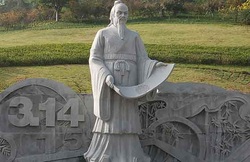
Zu Chongzhi was a Chinese astronomers during 429 - 500 A.D. His grandfather and father where both astronomers working for the emperor. The ancient Chinese believed that the emperor recived his power from the heaven. This made astronomers important people because they able give meaning to the heavens. Zu Chongzhi followed in his families service to the emperor. He also studied math through Liu Hui's commentary on the Nine Chapters on the Mathematical Art. One of his accomplishments, he was to be able to estimated the length of a year as 365.24281481 days . This approximation was accurate within 50 seconds. Using this Zu Chongzhi set out to find a more accurate calendar for his emperor. He presented Tam-ing calendar to the emperor Xiao-wu. Tam-ing calendar was over a cycle of 391 years with an extra month in the 144 year. His math was on the bases that there were 365 9589/39491 days in a year and 116321/3939 days in a month, By this idea you get 12 1691772624/4593632611 months in a year. Now by reducing the fraction we get 144/391. One the emperor mistresses ,Tai Faxin, objected to it because it was going against their ancient believes. Zu Chongzhi said his calendar was based on mathematical principles not on religious view. Xiao-wu sided with Zu Chongzhi and diced to put the calendar into use in the year 464, but the emperor died that year. The new emperor side with Tai Faxin and the Tam-ing calendar was never used

Zu Chongzhi produced an approximation for Pi. His approximation was 355/113 which is accurate to 9 decimal places. Unfortunately the book on how he did it was lost. In 656 , Zu Chongzhi method of interpolation was dropped out of studies because believed to be too complex for students. This might be a reason it was lost. People think he found the area of an inscribe 24576-gon to find his approximation for Pi. His later part of his life he collaborated with his son.
 RSS Feed
RSS Feed